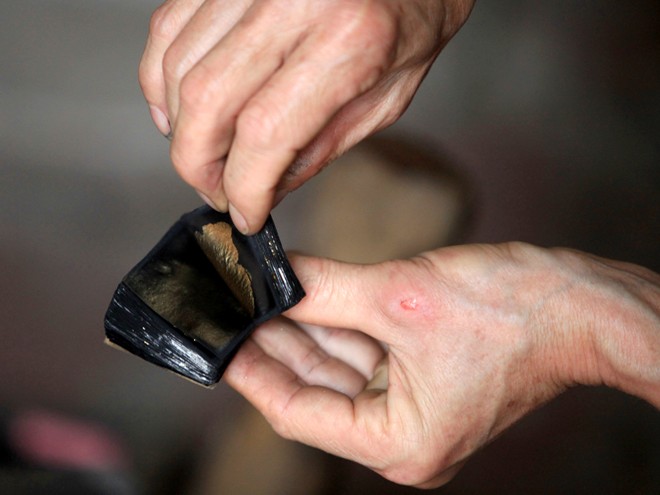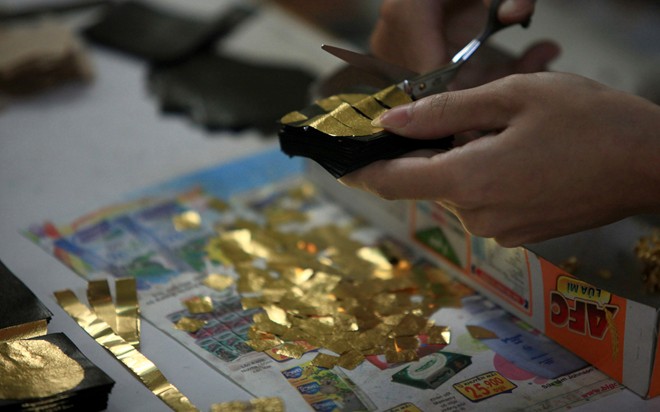Welcome To Vietnam News
Popular Posts This Week
Popular Posts This Month
Home » Travel
Laminating gold by hand in Hanoi’s old village
Monday, May 5, 2014
1/10 tael of gold can be laminated into a sheet of 1m2. The sheet is then cut into small square pieces of 1cm long to inlay on worshipping items.
Visiting historical relics and temples, visitors often see the gilded Buddha statues, horizontal lacquered boards and parallel sentences. Over a long period of time, these worshipping items are still beautiful. Most of them were made by talented hands of artisans in Kieu Ky village, Gia Lam district, Hanoi.
Over 500 years ago, Nguyen Quy Tri who lived during the Anterior Le Dynasty (1428- 1527) passed the craft down to Kieu Ky locals. Descendants of those locals now take his date of death, the 17th day of the eighth lunar month, as the annual chance to show their gratitude to the ancestor of the craft.
Craftsmen often start their work in the new year on the 14th day of the first lunar month with a ceremony, during which a famous and skilled man, often ready to help villagers, is given the honor of making the first hammer strikes.
Kieu Ky is the only village in Vietnam where the sheets are made from pure gold and silver, called old sheets, used exclusive for products in the village. Craftsmen only make decorative sheets from tin, called new sheets, outside the village where they go to practice the craft. Each household puts its own distinguishing characteristics on the products. That is why craftsmen can easily pinpoint who the manufacturers of the works are among their fellow villagers.
Coming to Kieu Ky, visitors find themselves in the busy life of the locals. Most of the villagers are peasants, but they hardly have any free time because, over 50 households engaged in the craft employ hundreds of the old and young alike.
Vu Thi Dac, 75, who has spent over 60 years in the craft, said : “this job requires experience, technique and sophisticated work before becoming a sheet.” First, pine resin is mixed with gelatin glue processed from buffalo skin. The mixture is then mixed with special raw paper pulp, then cut cut into 4cm x 6cm pieces. Small pieces of gold, sandwiched between those sheet, are hammered for nearly an hour before becoming a complete products.
The last stage of the work is to take the gold sheets out of the “moulds”, but this is by no means a simple task, as only a gentle breath would be enough to blow them away.
In recent years, together with the growth of the economy, various pagodas, and shrines are being restored, creating a chance for the development of the craft in Kieu Ky, as the demand for the sheets skyrockets.
Large volumes of the sheets are exported to Japan and Thailand, and this injects a new vitality to the craft. Kieu Ky craftsmen can feel proud because they have successfully restored and developed the unique legacy passed down to them by their ancestors.
Gilded Buddha statues.

To inlay gold on these items, workers use “la quy” – a special material made from giay do (do paper – made from the bark of the Rhamnoneuron balansae), covered by a special ink made from pine resin, sawdust, glue and buffalo leather glue. A completed “la quy” must be covered with this mixture thrice and dried. Melted gold and silver is casted into thin sheets and then put between “la quy” and laminated into thinner sheets. In photo: Completed “la quy”.

Silver sheets.

Nearly 50 families in Kieu Ky produce “la quy”. Some families hire more than 20 workers.

1/10 tael of gold can be laminated into a thousand sheets, covering 1sq.m of area. After gold sheets are added between “la quy”, workers have to wrap “la quy” by a cloth and hammer it to have thinner gold sheets. This is an important stage, deciding the color of gold sheets. This step takes about an hour.

Gold sheets are added between “la quy”. This step is called "long quy".

It takes about 30-45 minutes to hammer a “la quy”.

The final products: Each “quy” consists of 400-500 sheets of gold.

The stage called “trai quy” is also difficult. Workers have to take gold sheets in a very carefully way so gold sheets are not torn or stick to each other.

After hammering, workers cut gold sheets into small square pieces of 1cm.

This is a meticulous work.

One of the typical gilded products of Kieu Ky village is the Bodhisattva Kwan Yin statue at But Thap Pagoda. This statue was made in 1656 and until now it is still beautiful thanks to the gold layer inlaid by Kieu Ky workers.

Or the horizontal lacquered board and parallel sentences at Kim Ngan Temple in Hang Bac Street, Hanoi.
|





Comments[ 0 ]
Post a Comment